A desperate search for a missing five-person submersible has ended after pieces of the vessel were discovered following a likely “catastrophic implosion,” the U.S. Coast Guard said Thursday.
The vessel went missing Sunday morning while ferrying tourists to view the sunken wreckage of the Titanic off the coast of southeast Canada. It was said to have a 96-hour supply of oxygen, which the passengers would have exhausted by Thursday morning.
Wealthy British adventurer Hamish Harding, Pakistani businessman Shahzada Dawood, and his son Suleman were on board. French Navy veteran Paul-Henry “PH” Nargeolet, who would be driving the vessel, and Stockton Rush, CEO and founder of watercraft operator OceanGate Expeditions, were also among the crew.
Read live updates on the investigation below:
WSJ: Secret Navy System Detected Sub Implosion On Sunday
The Navy system is designed to detect enemy submarines and began listening for the sub after it lost communications.
“The U.S. Navy conducted an analysis of acoustic data and detected an anomaly consistent with an implosion or explosion in the general vicinity of where the Titan submersible was operating when communications were lost,” a senior U.S. Navy official told the paper in a statement. “While not definitive, this information was immediately shared with the Incident Commander to assist with the ongoing search and rescue mission.”
This Is The End Of Our Live Blog Coverage
Please visit HuffPost.com for further updates.
NewsNation Defends ‘Oxygen Countdown’ During Televised Segments On Missing Sub
The news outlet stood by its reporting in a statement to HuffPost on Thursday.
“The oxygen levels on the Titan submersible have always been an essential and important part of this story. Multiple media outlets have published or aired stories tracking the remaining oxygen on the Titan as the search continued. In fact, it would be irresponsible not to include this information in the story of the rescue effort,” a NewsNation spokesperson said in an email.
Still, there were multiple possible scenarios involving the missing craft, including an implosion.
“Is this new years eve? what's with the countdown?” one Twitter user tweeted.
“How insensitive having a countdown clock for oxygen…” another wrote.
Pointing to debris found near the site of the Titanic, the U.S. Coast Guard has said the implosion is what likely occurred, killing the passengers instantly.
Read more here.
Teen Passenger’s Aunt Says He Was ‘Terrified’ To Go On Voyage
Azmeh Dawood – the sister of passenger Shahzada Dawood – told the network through tears: “I feel disbelief. It’s an unreal situation.”
Her nephew ultimately decided to go on the trip with his dad because it fell over Father’s Day weekend.
“I feel like I’ve been caught in a really bad film with a countdown, but you didn’t know what you’re counting down to,” she continued. “I personally have found it kind of difficult to breathe thinking of them.”
Explorers Club Pays Tribute To Members Lost On Board Titan
“Our hearts are broken. I am so sorry to have to share this tragic news,” Richard Garriott de Cayeux, president of The Explorers Club, said in the statement.
Hamish Harding, one of the victims, is “a dear friend to me personally,” Garriott de Cayeux said.
Biden Administration Weighs In
“I offer my deepest condolences to the families and loved ones of the Titan’s passengers and crew during this incredibly difficult time,” reads the statement. “I commend the work and leadership of the United States Coast Guard on this extremely complex mission, and we are grateful to our interagency and international partners for their coordination in our search and rescue efforts.”
What Exactly Is A Catastrophic Loss Of Pressure?
As Scientific American explained this week: “That means every square inch of an [the submersible’s] surface experiences the equivalent of 5,500 pounds of force. Such an amount is greater than the bite pressure exerted by some of the strongest jaws in the animal kingdom.” Though it’s unclear at what point in its descent the submersible experienced the loss of cabin pressure, officials believe this led to its demise.
During Friday’s press conference, officials said the debris field was located 1,600 feet from the wreck of the Titanic and was consistent with an “implosion in the water column.” The comments suggest the vessel never reached the seafloor but rather experienced a catastrophic loss of cabin pressure during its descent.
Erik Cordes, a deep sea ecologist and professor at Temple University, told HuffPost that an implosion — much like an explosion — would have scattered pieces of the submersible into the water. That debris would have then rained down across an area of the seafloor.
Cordes has been on dozens of dives in manned submersibles and said: "It would implode but still send stuff everywhere.”

James Cameron: ‘Astonishing’ Similarities Between Titanic, Sub Disasters
“Deep submergence diving is a mature art,” Cameron said, noting that similar vessels have been rigorously pressure tested due to the threat of implosion. “Many people in the community were very concerned about this sub. And a number of the top players in the deep submergence engineering community even wrote letters to the company saying that what they were doing was too experimental to carry passengers.”
“I’m struck by the similarity of the Titanic disaster itself, where the captain was repeatedly warned about ice ahead of his ship, and yet he steamed at full speed into an ice field on a moonless night,” Cameron continued. “For a very similar tragedy where warnings went unheeded, to take place at the same exact site… I think is just astonishing. It’s really quite surreal."
Watch the interview here.
Read OceanGate's Full Statement
Coast Guard Press Conference Concludes
“I’m really grateful for all of the responders that came out to support this and really search for the vessel,” he said. “It is a difficult day for all of us, and it’s especially difficult for the families.”
The Coast Guard said no further press conferences are planned at this time.
Banging Noises Heard Appear Unrelated
He added, “This was a catastrophic implosion of the vessel, which would have generated a significant broadband sound” that would have been picked up by sonar detection.
Little Chance Of Finding Remains
“This is an incredibly unforgiving environment,” Mauger said. “We’ll continue to work and continue to search the area, but I don’t have an answer for prospects at this time.”
Coast Guard Says More Information Will Be Gathered
Mauger said the remotely operated vehicles will remain at the debris site to “continue to gather information.” He added they are still working to develop a timeline of what happened after the submersible disappeared.

Coast Guard: Sub Likely Experienced 'Catastrophic Loss’ Of Pressure Chamber
The debris “is consistent with the catastrophic loss of the pressure chamber of the missing submersible,” Mauger said.
Families of those on board were notified immediately after the discovery.
OceanGate: All Aboard Sub Perished
The statement continues: “This is a very sad time for the entire explorer community and for each of the family members of those lost at sea.”
Press Conference Starting Shortly
Marine Expert Says ‘Landing Frame And Rear Cover’ From Sub Found
“There’s a WhatsApp group between ourselves and The Explorers’ Club that we’ve all been connected to as soon as this happened, and our president is directly connected to the ships that are out there,” Mearns said. The club was founded at the turn of the 20th century to promote exploration.
“The message that they are telling me [is], if you are talking about debris, it was a landing frame and a rear cover from the submersible. So, again, this is a very unconventional submarine. That rear cover is the pointy end of it, and the landing frame is the little frame that it seems to sit on. And that’s how it gets docked into the landing bit. So that confirms it’s the submersible.”
Speaking earlier this week to the BBC, Mearns said that he personally knew two of the men on board the vessel — Hamish Harding and P.H. Nargeolet — through the Explorers’ Club.
The U.S. Coast Guard is expected to give an official update at 3 p.m. ET.
Debris Field Found During ROV Search: Coast Guard
The discovery was made by a remotely operated vehicle searching the area, which is being evaluated by experts within the unified command. That group reportedly consists of the U.S. Coast Guard, U.S. Navy, Canadian Coast Guard and OceanGate Expeditions.
A press briefing will be held at 3 p.m. EST to discuss the findings from the Horizon Arctic’s remotely operated vehicle, the Coast Guard said.
Read more about the discovery here:
https://www.huffpost.com/entry/debris-field-found-titanic-submersible_n_64946edfe4b0aec6b7ff3a6b#
Oxygen Supply’s Estimated Limit Has Expired
The vessel carrying five people was estimated to be equipped with a four-day supply of oxygen when it embarked early Sunday.
Experts suggested that the supply could last longer if the passengers were able to calm their breathing. If they panicked, the supply would run out faster.
“People’s will to live really needs to be accounted for, as well,” Rear Adm. John Mauger of the U.S. Coast Guard told NBC’s “Today” after the oxygen deadline passed.
“We’re going to continue searching throughout the day for this,” he said when asked if he remained hopeful.

Explorer Who Tested Titan Said He 'Couldn't Get Comfortable' With Its Design
"For us, on the dives that we did, I would say that some of the systems on board performed very well. Some of them didn't perform well at all. We had issues with thrusters, we had issues with computer control aboard," Gates told Sky News.
Gates added that there is a "totally different category of risk" attached to a vessel of this kind.
"It is truly experimental in a very real sense of the word," Gates said. "This is not like boarding a commercial flight on a new airplane. This is like being a test pilot on a plane that has never flown before."
2 ROVs Have Been Deployed In Search Area, U.S. Coast Guard Says
"The Canadian vessel Horizon Arctic has deployed an ROV that has reached the sea floor and began its search for the missing sub," the Coast Guard's First District wrote on Twitter.
Horizon Arctic "has a hangar for remotely operated vehicles (ROVs) with a launch and recovery system," CNN reported.
French vessel L'Atalante has also launched its ROV in the search area in what appears to be another crucial development. CNN reported the vessel "can dive to almost 20,000 feet," which is about 7,000 feet deeper than the Titanic wreck, the five-person Titan expedition's target.
L'Atalante's ROV "can perform tasks including video and acoustic search and inspection and has robotic arms that can manipulate objects," the network said, citing the French Oceanographic Fleet.
Oceanographer Says It's A 'Misnomer' To Put Exact Deadline On Depletion Of Oxygen Supply
But Simon Boxall, a professor of oceanography at the U.K.'s University of Southampton, said it's a "misnomer" to timestamp when the missing submersible's oxygen might be exhausted.
"They’re estimates and it does depend very much on the exact capacity in those bottles," Boxall told Sky News. "It depends also on how the people in the sub are reacting.”
“If they’re panicking, they would have run out already. If they are conserving oxygen somehow then they could last a bit longer," Boxall added.
In a separate interview with NBC News, Boxall said what is known is that the depletion of breathable air for those aboard is "imminent."
2 More Vessels Arrive On Search Scene, U.S. Coast Guard Says
The Horizon Arctic is now one of five key vessels in the search, according to CNN.
"The Canadian 307-foot anchor handling vessel has a hangar for remotely operated vehicles (ROVs) with a launch and recovery system," the network reported.
Here’s the latest:
- The U.S. Coast Guard said Wednesday the mission for the lost submersible continues to be a search-and-rescue operation. Experts believe the crew could run out of oxygen sometime Thursday morning.
- Officials said underwater sounds had been detected in the search area multiple times, but searches so far have not turned up anything. “We don’t know where they are,” U.S. Coast Guard Capt. Jamie Frederick said. “You always have hope.”
- A deep sea ecologist told HuffPost the mysterious banging could be the crew trying to signal for help. “Sound travels so well underwater,” the expert said. “That would really be the only way that you had to let people know you are still alive.”
- Experts have predicted a difficult decision may have to be made sometime Thursday as oxygen stores expire.

Submersible Pilot's Wife Is A Descendant Of Couple Who Died On The Titanic
Wendy Rush is the great-great-granddaughter of Isidor Straus and his wife, Ida, who were both aboard the Titanic in 1912 when it sank.
The couple, who were among the wealthiest people on the ship, shared a tragic fate the day the ship went down.
Survivors of the disaster recalled that Isidor refused a seat on a lifeboat after seeing that women and children were still waiting to flee, the Times reported. His wife, Ida, refused to leave her husband, and survivors say the two went down with the ship with their arms linked — a scene that was memorialized in James Cameron’s film “Titanic.”
Deep Sea Explorer Provides Insight On Banging Noises, Rescue Challenges
But Cordes, a deep sea ecologist and professor at Temple University, is holding out hope that the mysterious banging noises detected near where sub went missing is the five-member crew trying to signal for help.
It remains unclear what caused the vessel to go missing in the North Atlantic on Sunday. But if it completely lost communications or power, hitting the side of the hull would be “the only way” for the crew to try to communicate, Cordes told HuffPost.
“Sound travels so well underwater,” said Cordes, who has been on dozens of dives in manned submersibles. “That would really be the only way that you had to let people know you are still alive.”
Rolling Stone reported Tuesday that a Canadian aircraft detected "banging sounds" in 30-minute intervals in an area “close to the distress position.”
“You would want to do it at some sort of regular intervals so that people knew it wasn’t natural, that it was manmade,” Cordes said. “Something that regular and periodic would make sense to me, that that would be the contingency plan for signaling the surface if everything else went wrong, because that’s really all you’ve got."
Cordes said the biggest issue facing the crew is the dwindling supply of breathable air, which could run out by early Thursday. But Cordes stressed that that is just an estimate.
“There’s a lot of complicated math there, a lot of variance in peoples’ bodies,” he said. “If they are panicking, they could use up air more quickly. If they know and understand their situation and they’re being very logical, they could be somehow trying to meditate, conserve air, sleeping and not breathing as much.”
Cordes knows and has worked with Stockton Rush, the CEO and founder of OceanGate Expeditions who is one of the five people aboard the missing vessel. Cordes said he hopes that Rush and the others will be brought safely home.
“When there is a chance for them to still be alive, you should be trying everything you can to get down there,” he added.
Cordes also weighed in on the complicated nature of the ongoing rescue effort. If rescue officials are able to locate the vessel using scanning sonar, they would likely attempt to use an unmanned remotely operated vehicle, or ROV, to attach a cable onto the vessel and hoist it to the surface, he said.
Potentially complicating such a recovery is that the Titan launches from and lands from a submerged platform rather than a winch.
“There’s got to be something on the external part of the submersible they could hook into, but that’s not normally part of launch and recovery of this vehicle, which is really different — another thing that’s really different about this vehicle,” Cordes said. “It was sort of innovative but now may present a problem.”
Retired Navy Captain: Passengers Are Likely ‘Freezing Cold’
"They're freezing cold,” Marquet, who is a former submarine captain, told the network. “The water entirely surrounding the ship is at freezing or slightly below. When they exhale, their breath condenses. There's frost on the inside of the parts of the submarine. They're all huddled together trying to conserve their body heat. They're running low on oxygen and they're exhaling carbon dioxide."
Would-Be Passenger Found Titanic Exhibition Too Dangerous
“This one, there seemed to be a lot of risks that were outside my control,” Brown said Wednesday afternoon, noting how the submersible currently missing had continually failed to meet testing goals. A lawsuit filed by an ex-employee in 2018 made similar accusations.
“It didn’t come across as a professional diving operation to me,” he said. Knowing he could have been on the voyage, Brown said, “I take no pleasure from that. The situation is horrendous.”
But he said there was some hope in the noises heard by rescuers scouring the seas. Brown said that his resourceful acquaintance Hamish Harding, a British explorer who was on the submersible, could have come up with the noisemaking as a plan to aid rescuers.
“By making a noise at a set frequency — that’s an indication of intelligent life below the ocean,” Brown said.
Lost Passengers Have Some Food, Though Were Advised To Restrict Diet Before Trip
“There's no food and water, apart from the one sandwich and the one water bottle you bring with you,” David Pogue, a CBS reporter who rode the submersible to the Titanic's wreckage last year, recently told News Nation.
Mike Reiss, a producer and writer for “The Simpsons” who also toured the Titanic last year, said that passengers were provided some sandwiches and water during his descent.
Health experts advise drinking 2.7 to 3.7 liters of fluids daily to stay adequately hydrated. Signs of dehydration include dizziness, lightheadedness, muscle cramps, headache, fainting and confusion. If untreated, dehydration can lead to kidney damage, brain damage and death.
The passengers may not have been well-fed or hydrated before embarking on their voyage Sunday morning, however, as the company’s website advises riders to restrict their diets before entering the vessel to reduce the chances of having to use the bathroom.
Reiss described the bathroom on his podcast as a two-piece “potty seat.” Pogue, in his past CBS report on his trip, said it featured Ziploc bags that were used to catch human waste.

Officials: Noises Heard Multiple Times, 'Nothing Is Ruled Out'
“We don’t know what they are,” U.S. Coast Guard Cpt. Jamie Frederick said at a press conference. “You always have hope. That’s why we do what we do.”
Carl Hartsfield of the Woods Hole Oceanographic Institution, which has been assisting the search, said the sounds “have been described as banging noises.”
Hartsfield said experts are working to eliminate other potential man-made sources for the sounds besides the submersible.
At this point, he said, “nothing is ruled out” in terms of the sounds’ origin.
The search has expanded to an area that’s twice the size of Connecticut and two and a half miles deep, Frederick said.
There are currently five surface assets combing the area, and a total of 10 are expected within the next 24 to 48 hours. There are also two remote-operated vehicles searching beneath the waves, with more slated to join the effort, Frederick said.
More Search Vessels Arrive Near Titanic Wreckage After 'Underwater Noises' Detected
The vessels were identified as the Canadian Coast Guard ships John Cabot and Atlantic Merlin, and the commercial ship Skandi Vinland.
The three vessels are among eight that on Tuesday were en route to the search site.
The John Cabot has side-scanning sonar capabilities and is conducting search patterns alongside the two other vessels, the Coast Guard said on Twitter.
The Skandi Vinland is equipped with two remotely operated vessels, according to Norwegian supply shipping company DOF, which operates the ship. The company said in a statement that the Skandi Vinland arrived at the search site Tuesday evening and can provide 24-hour assistance.
The Atlantic Merlin also carries a remotely operated vessel.
The arrival of the ships follows the Coast Guard's confirmation that underwater sounds had been detected at the site of the Titanic wreckage. Rolling Stone, citing internal government emails, reported Tuesday that an aircraft detected "banging sounds" every 30 minutes in an area “close to the distress position.”
Ex-Sub Tourist: Passengers Likely Conserving Oxygen To Extend Survival Time
“They would be conserving energy from day one. I wouldn’t be surprised if the oxygen lasts a lot longer because they know exactly what to do,” Oisin Fanning told BBC Radio.
The submersible is equipped with 96 hours of oxygen, which authorities have suggested may be depleted by Thursday morning.
Fanning credited two of the men on the vessel, whom he previously traveled with, as “consummate professionals” who have dived to the Titanic wreckage dozens of times. They likely are advising the others not to panic, he said.
“If I was in trouble, I’d want to be on a sub with them,” he said of French explorer Paul-Henri Nargeolet and OceanGate CEO Stockton Rush.
British explorer Hamish Harding, who is also on the lost vessel, has previously explored the Mariana Trench, the deepest part of the earth's oceans.
In a separate interview with The New York Times, Fanning described the submersible's landing spot as unpredictable.
In one of his dives, he said, the submersible landed about 400 feet from the wreckage. If ocean currents were stronger, the vessel could have landed more than half a mile away.
“You don’t have control. This thing isn’t motorized,” he said.
Navy Noise Experts Examining Sound, Coast Guard Says
“You have to remember that it’s the wreck site of the Titanic, so there is a lot of metal and different objects in the water around the site,” Coast Guard Rear Adm. John Mauger said on "CBS Mornings."
“That’s why it’s so important that we’ve engaged experts from the Navy that understand the science behind noise and can classify or give us better understanding of what the source of that noise may be,” he said.
The Coast Guard said it has moved an underwater robot to the area where the sound was heard. A surface vessel equipped with sonar is also in the area, Mauger said, “to see if we can detect anything in the water in that area.”
Rolling Stone, citing internal government emails, reported Tuesday that a Canadian aircraft detected "banging sounds" every 30 minutes in an area “close to the distress position.”

OceanGate CEO Sued By Couple Claiming Fraud
A Florida couple sued Stockton Rush, CEO of OceanGate Expeditions, in February for fraud, claiming that they had paid deposits to go to the Titanic shipwreck in 2018 but their trip was canceled and refund request ignored, the Independent reported.
There's been no activity on the court filing by Marc and Sharon Hagle, and a company spokesperson told the Independent it had no comment.
The filing details the couple's claims that they paid to take a trip on the "Cyclops 2," as the Titan submersible was then called, and that Rush traveled to their Orange County home to reassure them that the voyage was still happening despite repeated delays.
'Best Thing' Missing Crew Can Do Is 'Conserve Their Breathing,' Astronaut Says
"Every breath that they take consumes oxygen and that's their limiting factor," Virts, an astronaut and friend of British explorer and businessman Hamish Harding who is aboard the sub, told "BBC Breakfast."
"So they need to minimize the oxygen they breathe in, the carbon dioxide they breathe out. They could be sleeping, they could take some sleeping medicine."
Virts added the crew is hopefully behind the noise that rescuers have heard in the search area, and could send out more signals like SOS and Morse code "so we know it's actually coming from humans."
'Circumstances Are Against' Rescue Operation, Specialist Says
"Every hour that goes by, the chances do become less of a safe recovery," he told Sky News.
Welham added that the banging sounds heard in the search area indicate someone among the crew has "taken charge."
"If they can continue to do that it gives the searchers something to pinpoint," Welham continued.

Oceanographer Says Banging Sounds Good Sign But 'Time Is Running Out'
"Time is of the essence because once you ... have an area where you know that the bangs are coming from ... you need to get assets there — submarines and robots — over that spot to investigate," Gallo told CNN.
In a tweet the U.S. Coast Guard confirmed underwater noises were heard but said remote operated vehicle searches have so far "yielded negative results."
Gallo, who described missing crew member Paul-Henri (P.H.) Nargeolet as a good friend and colleague, said he could be the one generating the banging sounds.
Nargeolet has been praised by OceanGate Expeditions as a Titanic expert and French Navy veteran and has led several expeditions to the Titanic site.
He "is the kind of person that if he were in that submarine, he would think this thoroughly through and would do something like that every 30 minutes," Gallo told CNN's Alisyn Camerota.
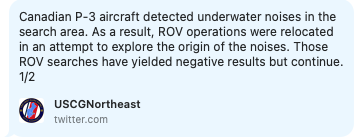
Memos Reveal 'Banging' And 'Tapping' Sounds Detected During The Search
“RCC Halifax launched a P8, Poseidon, which has underwater detection capabilities from the air,” the email sent to the Department of Homeland Security stated.
It continued: “The P8 deployed sonobuoys, which reported a contact in a position close to the distress position. The P8 heard banging sounds in the area every 30 minutes. Four hours later additional sonar was deployed and banging was still heard.”
The memo did not state when the banging sounds were first detected on Tuesday or what may have caused the sounds.
Another update sent Tuesday night again detailed that sounds were detected. But the sounds weren’t described as “banging,” CNN reported.
“Additional acoustic feedback was heard and will assist in vectoring surface assets and also indicating continued hope of survivors,” the update stated.
According to an email sent Tuesday afternoon from the president of the Explorers Club, a research group, additional sounds were detected at 2 a.m. local time from the location but were described more as a “tapping” noise, “implying crew may be alive and signaling.”
The email urged the group to contact their representatives to use remote-operated vehicles (ROV) made by a private British company to assist, stating that two Explorers Club members were aboard the Titan, Rolling Stone reported.
“A team out of the UK named Magellan has an ROV rated for 6,000 meters which is loaded on a plane and ready and waiting to help,” the email stated. “BUT THE US GOV and USCG have not yet given them permits to participate!”
The Boston Coast Guard, Joint Rescue Coordination Centre, U.S. Fleet Forces Command, the DHS and the U.S. Coast Guard did not respond to a request from Rolling Stone for comment on the detected sounds. OceanGate, the U.S. Coast Guard in Boston and Canadian authorities did not respond to CNN’s request for comment.
CORRECTION: This post initially attributed an email to the Explorers Society based on Rolling Stone's report; the group is called The Explorers Club.
Coast Guard: A 'Unified Command' Has Been Established As Search Continues
More than 10,000 square miles had been searched as of Tuesday morning, which was made possible due to weather improvements and increased visibility.
The Coast Guard said that at 7 a.m. EDT, a Bahamian research vessel arrived on scene and began remotely operated vehicle (ROV) operations.
The search was then continued at about 4 p.m. EDT by a crew from the Air National Guard 106th Rescue Wing. Now there are six vessels and ships on their way to continue the search, the Coast Guard said.
“This is a complex search effort which requires multiple agencies with subject matter expertise and specialized equipment which we have gained through the unified command,” Capt. Jamie Frederick, the response coordinator for the 1st Coast Guard District said in the statement Tuesday night.
Frederick added: “While the Coast Guard has assumed the role of Search and Rescue Mission Coordinator, we do not have all of the necessary expertise and equipment required in a search of this nature. The Unified Command brings that expertise and additional capability together to maximize effort in solving this complex problem.”

Missing Sub Rider Accepted Risk Of No Rescue
“If something goes wrong, you are not coming back,” Harding, a British businessman, had told The Week.
Harding’s dive to the Mariana Trench, which is the deepest part of the ocean, set two Guinness World Records.
Harding is a passenger on the missing submersible craft.
Read Nina Golgowski's report on his previous dive here.
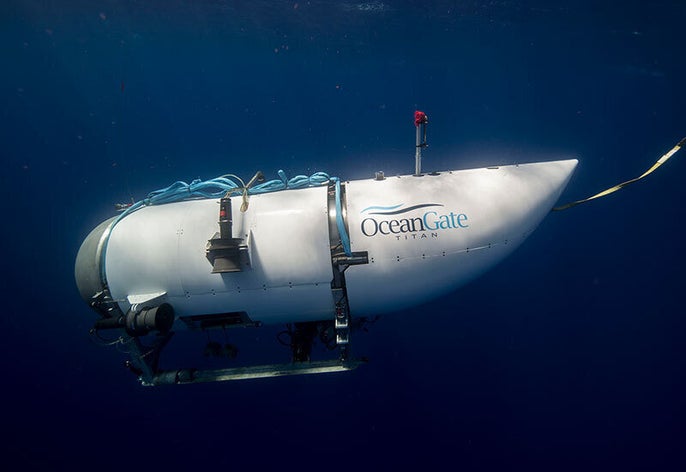
Marine Tech Experts Warned Of ‘Catastrophic’ Outcome
The Marine Technology Society, made up of scientists and engineers, sent the letter expressing “unanimous concern” to OceanGate CEO Stockton Rush on March 27, 2018, according to a New York Times report.
“Our apprehension is that the current experimental approach adopted by OceanGate could result in negative outcomes (from minor to catastrophic) that would have serious consequences for everyone in the industry,” the letter warned.
The group accused OceanGate of not intending to follow internationally agreed-upon regulations set by the DNV-GL, a classification society that sets standards for the structures of marine vessels.
The group urged Stockton to test a prototype of the Titan with DNV-GL.
They also suggested that Titan’s marketing materials falsely advertise that the submersible’s design would “meet or exceed the DNV-GL safety standards.”
The group wrote, “Your representation is, at minimum, misleading to the public and breaches an industry-wide professional code of conduct we all endeavor to uphold.”
U.S. Military Sending Salvage Equipment In Case Needed
FADOSS is a “ship lift system designed to provide reliable deep ocean lifting capacity of up to 60,000 pounds for the recovery of large, bulky, and heavy sunken objects such as aircraft or small vessels,” the Navy says on its website. Last year, it was used to recover an F-35C Lightning II Joint Strike Fighter from a depth of more than 12,000 feet underwater.
Yes, There Is A Bathroom On The Sub
On a now-defunct website for its Titanic exhibitions, OceanGate recommends that passengers “restrict your diet before and during the dive to reduce the likelihood that you will need to use the facilities.” If required, however, its location at the front window makes it “the best seat in the house."
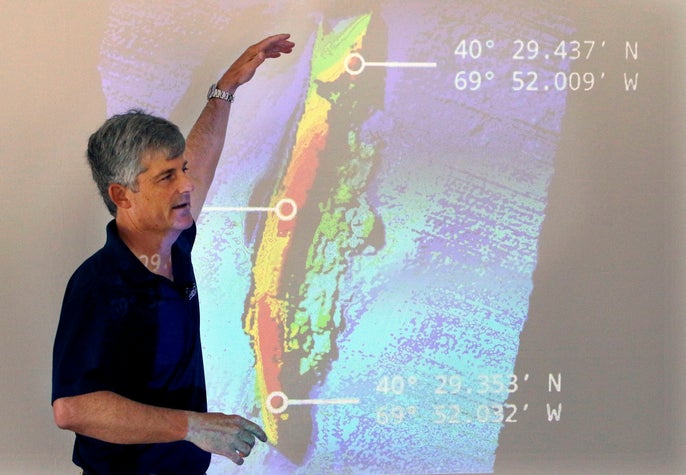
Ex-Employee Tried Sounding Alarm On Sub Safety At Extreme Depths
In 2018, while David Lockridge was serving as the company’s director of marine operations, he tried sounding the alarm over the submersible’s hull design but was ignored and fired, according to legal documents obtained by The New Republic.
OceanGate reportedly sued Lockridge for breach of contract after he refused to OK manned tests. Lockridge then filed a counterclaim, stating in part that “visible flaws” had been noticed in “carbon end samples for the Titan,” the vessel that is now missing. Its hull is made of five-inch-thick carbon fiber.
The documents stated that Lockridge “again stressed the potential danger to passengers of the Titan as the submersible reached extreme depths. The constant pressure cycling weakens existing flaws resulting in large tears of the carbon. Non-destructive testing was critical to detect such potentially existing flaws in order to ensure a solid and safe product for the safety of the passengers and crew.”
Lockridge alleged that the company’s leadership also refused to pay for a viewing portal that could withstand more than 4,300 feet of pressure; the wreck of the Titanic lies 13,000 feet underwater.
Another lawsuit, filed this February by a Florida couple, alleges that OceanGate CEO Stockton Rush misled the pair into spending over $210,000 on a voyage that never transpired because the Titan was failing safety tests, The Daily Beast reported. Rush is believed to be aboard the missing submersible, along with four others.
Coast Guard Says Sub Has 40 Hours Of Oxygen Left
U.S. Coast Guard Cpt. Jamie Frederick, speaking to reporters, said 7,600 square miles have been searched but “to date, those search efforts have not yielded any results.” He said more aircraft are scheduled to join the search today and that the Coast Guard is using a remotely operated vehicle (ROV) to search the last known location of the vessel.
Frederick called the search both “unique” and “challenging.” Crews have to search both under the water and at the surface. It’s also physically difficult to reach the remote area, which is about 900 miles off Cape Cod, especially for large vessels carrying heavy equipment.
“Nine hundred miles is an enormous amount of distance,” said Coast Guard Public Affairs Chief Robert Simpson, who added that the rescue coordination center is in Boston.
Depending on the vessel and where it’s departing from, it could be a matter of “two days to four to five days” to reach the location, said Simpson.
He said there was little visibility during Monday’s search due to fog but that the conditions have been improving.
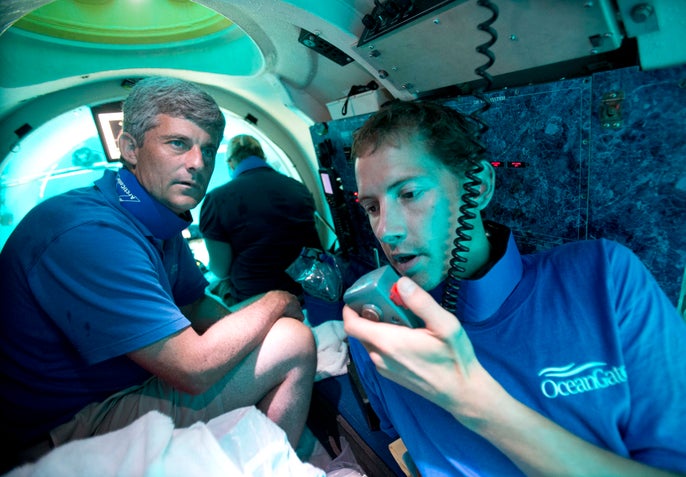
Sub’s CEO Expressed Concerns Of Not Resurfacing
"What I worry about most are things that will stop me from being able to get to the surface," Stockton Rush (pictured at left) said on reporter David Pogue’s podcast, "Unsung Science."
"Overhangs, fish nets, entanglement hazards. And, that's just a technique, piloting technique. It's pretty clear — if it's an overhang, don't go under it. If there is a net, don't go near it. So, you can avoid those if you are just slow and steady,” he said.
Rush added that everything in life involves risk but that he felt safe making the trek.
"I don't think it's very dangerous. If you look at submersible activity over the last three decades, there hasn't even been a major injury, let alone a fatality," he said.
A former ABC News correspondent who completed the same dive in 2000, said his vessel found itself unable to surface when a strong underwater current propelled him and his crew beneath the ship’s stern.
Michael Guillen, recalling his experience on Twitter on Tuesday, said the incident “almost claimed my life” and that it took some time for the submersible he was in to get free.
Adding A Beacon To Sub Was Discussed
A passenger told "CBS Sunday Morning" that the vessel was lost for two and a half hours.
Pogue said the submarine does not have any kind of beacon like an aircraft's emergency locator transmitter that could be detected by searchers, but he said adding one was discussed after the previous incident with the lost vessel.
Sub Uses Video Game Controller, Which Military Does Too
OceanGate founder and CEO Stockton Rush showed off one of the gaming controllers during a tour of the submersible last year with the CBC.
“It’s meant for a 16-year-old to throw it around and it’s super durable. We keep a couple spares on board just in case,” he said of the Bluetooth-equipped device.
In 2017 the U.S. Navy announced it would use Xbox 360 controllers to operate periscopes on some of its newer, more advanced submarines.
“The Navy got together and they asked a bunch of [junior officers] and junior guys, ‘What can we do to make your life better?’” Lt. j.g. Kyle Leonard, the USS John Warner’s assistant weapons officer, told The Virginian-Pilot. “And one of the things that came out is the controls for the scope. It’s kind of clunky in your hand; it’s real heavy.”
Other cited perks of using a video game controller is that they can be easily replaced and that many sailors are already familiar with how to use them.
Friend Of Missing Sub Crew Member Shares Her Biggest Concern
"I do believe that his training will serve him well because he is a seasoned pilot and he's proven his durability by flying into space," among other places, Jannicke Mikkelsen told Sky News.
Mikkelsen added that she is most concerned about the possibility of the crew "being stuck at the bottom of the ocean with 96 hours of air and not able to get back to the surface."
U.S. Coast Guard: 10,000 Square Miles Searched So Far
Current search efforts include the use of Canadian aircraft that can detect submarines using sonar. Two research vessels, including the ship that the submersible was launched from, are continuing to search the water’s surface, the Coast Guard said.
Company Behind Missing Sub Says Starlink Made Prior Titanic Expeditions 'A Success'
There is no evidence to suggest Musk’s company is in any way responsible for the loss of communication between the Titanic vessel and the Polar Prince ship.
Starlink, which is operated by SpaceX, is a satellite constellation that delivers internet capabilities in remote locations.
“Without any cell towers in the middle of the ocean, we are relying on @Starlink to provide the communications we require throughout this year’s 2023 Titanic Expedition,” OceanGate Expeditions, which operates the five-person sub, wrote on Twitter last week in another post.
Man Recalls Sub Getting Stuck Under Titanic’s Stern During 2000 Dive
Michael Guillen on Tuesday shared a video clip from his trip on Twitter while recalling how the accident “almost claimed my life.”
In the video shot for ABC News, Guillen says a strong underwater current pushed their vessel up to the ship’s propellers along the seafloor. When they tried to back out, they found themselves stuck beneath the stern.
Guillen also recalled the harrowing incident in his 2021 book, “Believing Is Seeing,” according to the Daily Mail.
In his book, he said his vessel slammed into the ship and it took them 30 minutes to break free.
“I felt the shock of the collision: rusty debris showered down on our submersible, obscuring my view through the porthole,” he wrote.
Just when he thought they would never escape, the watercraft broke free after extensive “forward and backward” rocking by the team.
Marine Scientist Shares 'Some Hope' Missing Vessel Could Be Located
“Another commercial vessel, a very capable pipe laying vessel, modern ship, with ROV [remotely operated underwater vehicle] capabilities, is actually over the site now and we’re just hoping that it has the capabilities to reach those kind of depths — 3,800 meters — to search for the submersible and have the ability to recover it,” Mearns told the network.
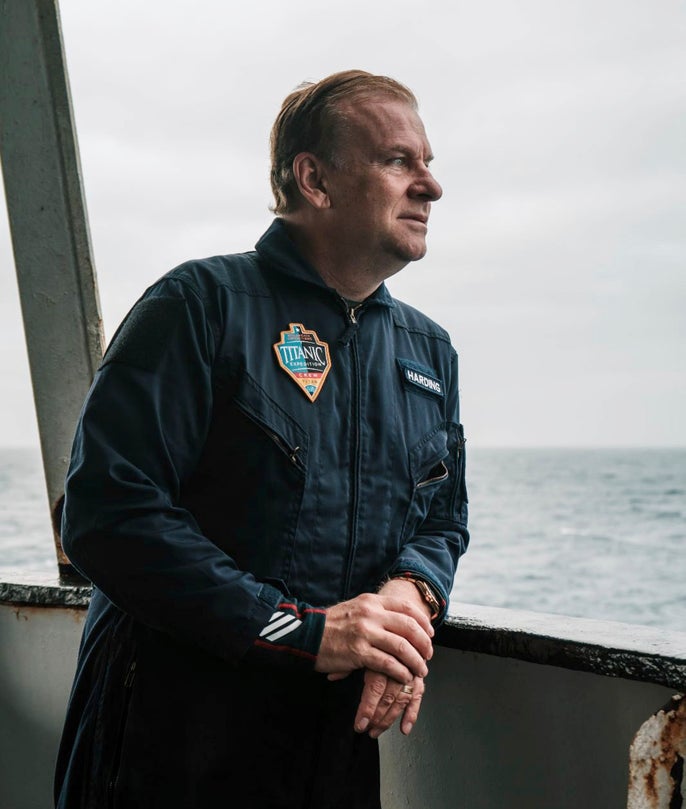
The People Thought To Be Aboard The Missing Vessel
Hamish Harding (pictured), a British explorer and businessman, was part of the crew, Richard Garriott de Cayeux, the president of the The Explorers Club, said in a statement.
Harding was a founding member of the professional society's Board of Trustees.
"His excitement about this expedition was palpable," Garriott de Cayeux said. "I know he was looking forward to conducting research at the site. We all join in the fervent hope that the submersible is located as quickly as possible and the crew is safe."
Shahzada Dawood, a Pakistani businessman who lives in the U.K., and his son, Suleman Dawood, were also aboard, the family confirmed.
“We are very grateful for the concern being shown by our colleagues and friends and would like to request everyone to pray for their safety while granting the family privacy at this time," they said in a statement.
Paul-Henri (P.H.) Nargeolet, who has been praised by OceanGate Expeditions as a Titanic expert and French Navy veteran and has led several expeditions to the Titanic site, was on the vessel, his family told CNN affiliate BMFTV.
Sky News is also reporting that Stockton Rush, the CEO and founder of Oceangate Expeditions, was thought to be aboard the missing submersible.
Coast Guard Says It Has An Idea Of Where Vessel Was Operating
“We do have an understanding of where the vessel, the submersible was operating and so we’re prioritizing search in those areas,” he said.
Mauger added that OceanGate Expeditions is leading the underwater search, reasoning that “they know that site better than anybody else.”
He did not say that he’s optimistic about finding the missing submersible when asked, instead saying that the group is using all resources available in its search efforts.
“The thoughts of the crew members and their families really drive our crews forward,” he said.
Oceanologist Says Crew Sent Out 'Emergency Ping'
“This is second-hand knowledge but my understanding is that they have received a signal from the submarine," Boxal told PA News, according to The Independent.
Boxal added he didn't know the timing of when the signal went out.
"I don’t know if that is automatically generated or generated by people on board," he said.
Writer Says He Had To Sign Waiver Mentioning Death '3 Times' Before Trip
"You sign a massive waiver that lists one way after another that you could die on the trip," Reiss said. "They mention death three times on page one."
You can listen to the full segment below:












